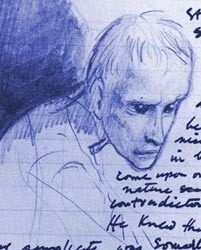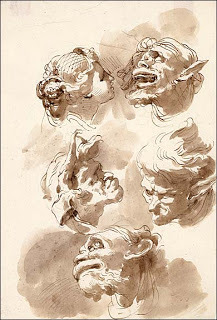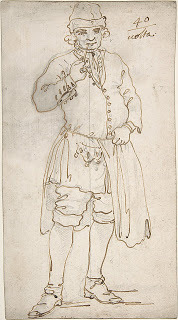"Anything, seen without prejudice, is enormous": Mervyn Peake, caricature, and the baroque roots of modern fantasy literature


Mervyn Peake wrote: "For drawing should be an attempt to hold back from the brink of oblivion some fleeting line or rhythm, some mood, some shape or structure suddenly perceived, imaginary or visual. Something about a head that calls out to be recorded: something about the folds of a long cloth: the crawling wave; the child; the tear; the brood of shadows. That movement of the arm that hinted fear: that gesture that spelt amazement: the dream; the alleyway; clown; broker; stone or lizard. The quicksands closing on a centaur's head tokens no more of magic than the penny loaf. ... Anything, seen without prejudice, is enormous" (from his 1946 booklet, The Craft of the Lead Pencil; above are his sketches of Steerpike and the Countess Gertrude, below of Flay with little Titus, Fuchsia, and Flay alone, illustrations to Peake's novels of Gormenghast ).


 While Tolkien from his seat at Oxford was at the same mid-century moment creating (or updating) a Mythos For England, based on "that Northern thing," Peake-- ensconced on Sark in the Channel Islands just off the French coast--was plumbing the Universal in the melancholy comedies and grotesqueries of Gormenghast. Peake is that decidedly un-English thing: a practitioner of the baroque, a Mannerist, an open sluice for rococo passion. Where Middle-Earth is thick and delineated by maps (both for the characters and for the reader), Gormenghast is endless and unknown to those who reside there and to the reader...and outside Gormenghast the territory becomes utterly unmarked, inchoate, as Titus learns in his exile. Middle-Earth is earnest, realistic, precise, multitudinous, full of exteriors described...Gormenghast is exaggerated, surrealistic, romantic, suggestive, full of interiors portrayed.
While Tolkien from his seat at Oxford was at the same mid-century moment creating (or updating) a Mythos For England, based on "that Northern thing," Peake-- ensconced on Sark in the Channel Islands just off the French coast--was plumbing the Universal in the melancholy comedies and grotesqueries of Gormenghast. Peake is that decidedly un-English thing: a practitioner of the baroque, a Mannerist, an open sluice for rococo passion. Where Middle-Earth is thick and delineated by maps (both for the characters and for the reader), Gormenghast is endless and unknown to those who reside there and to the reader...and outside Gormenghast the territory becomes utterly unmarked, inchoate, as Titus learns in his exile. Middle-Earth is earnest, realistic, precise, multitudinous, full of exteriors described...Gormenghast is exaggerated, surrealistic, romantic, suggestive, full of interiors portrayed.English-language fantasy fiction has since, as is well-known, overwhelmingly followed the Tolkienian mode, harking back to Beowulf, to the sagas, the eddas, the lists of dwarves fleeing through Mirkwood. Modern fantasy does not favor its other parents, including the ones celebrated by Peake. He is a caricaturist in the finest, fullest sense of that word, distorting the external to reveal an essential truth (it is arguably harder to produce a good caricature than it is to render a good realistic portrait). Caricature does not sit well in our modern field of fantasy; to extend the analogy, the market right now demands grand historical and quasi-religious paintings. Few modern fantasists can be considered caricaturists (my short list includes Jeff VanderMeer, Sylvia Townsend Warner, D.M. Cornish, Angela Carter, Theodora Goss, Jesse Bullington, and perhaps needless to say, Italo Calvino), and fewer of those have enjoyed the kind of commercial success accruing to writers of the grand epic.
I am no Peake scholar but I have to believe that Peake, a professional artist, had immersed himself in the great Italian and Spanish traditions of caricature, beginning with his studies at the Croydon School of Art and the Royal Academy Schools, and then as a teacher at the Westminster School of Art and at the Central School of Art in Bloomsbury. I have neither time nor space today at Lobster & Canary to do more than toss forth below some examples of the sorts of latinate visions I imagine Peake knew well. I encourage us as we review our genre's recent history to acknowledge not only the Northern elves but also the hippogriffs and pantagruels of the South, not only the stern reality of dragons and rings but the traditions that give us the labyrinth of the lady Gertrude's mind, the depths of Flay's devotion, the anguish of the seventy-seventh Earl of Groan.
 [Ubaldo Gandolfi, a study of heads, c. 1760-?]
[Ubaldo Gandolfi, a study of heads, c. 1760-?] [Goya, They Are Hot, 1799]
[Goya, They Are Hot, 1799]
[Parmigianino, Figures in a Ferry Boat, c. 1535]

[Parmigianino, The Mystic Marriage of Saint Catherine, c. 1527]

[Canaletto, Study of a Man, c. 1750-?]

[Pier Leone Ghezzi, Study of a Lawyer? c. 1725?]Daniel A. Rabuzzi is author of the fantasy novel "The Choir Boats," available from ChiZine Publications in September 2009.
"The Choir Boats" explores issues of race, gender, sin, and salvation, and includes a mysterious letter, knuckledogs, carkodrillos, smilax root,
goat stew, and one very fierce golden cat.
(www.danielarabuzzi.com). Daniel blogs at Lobster & Canary about speculative fiction, poetry, history and the arts.
Published on July 29, 2012 03:16
No comments have been added yet.



